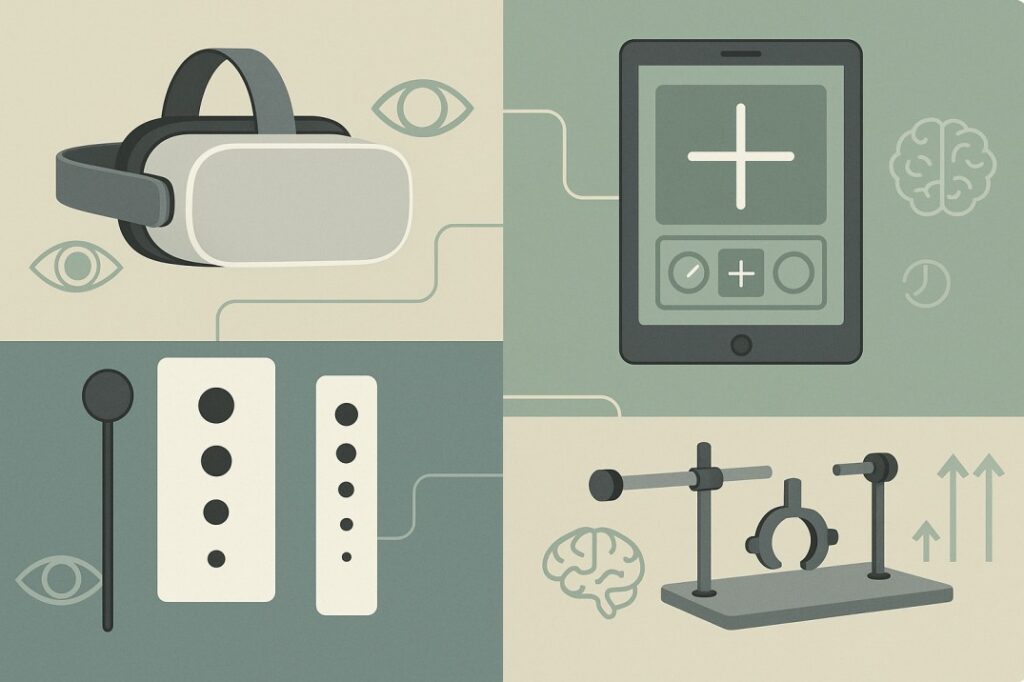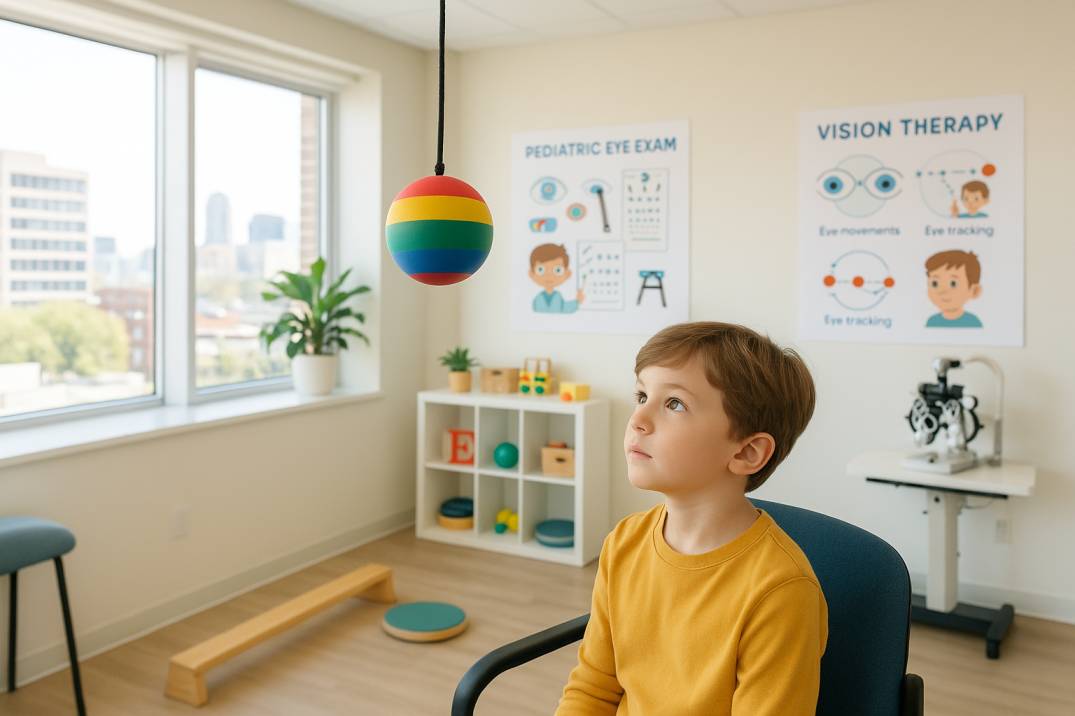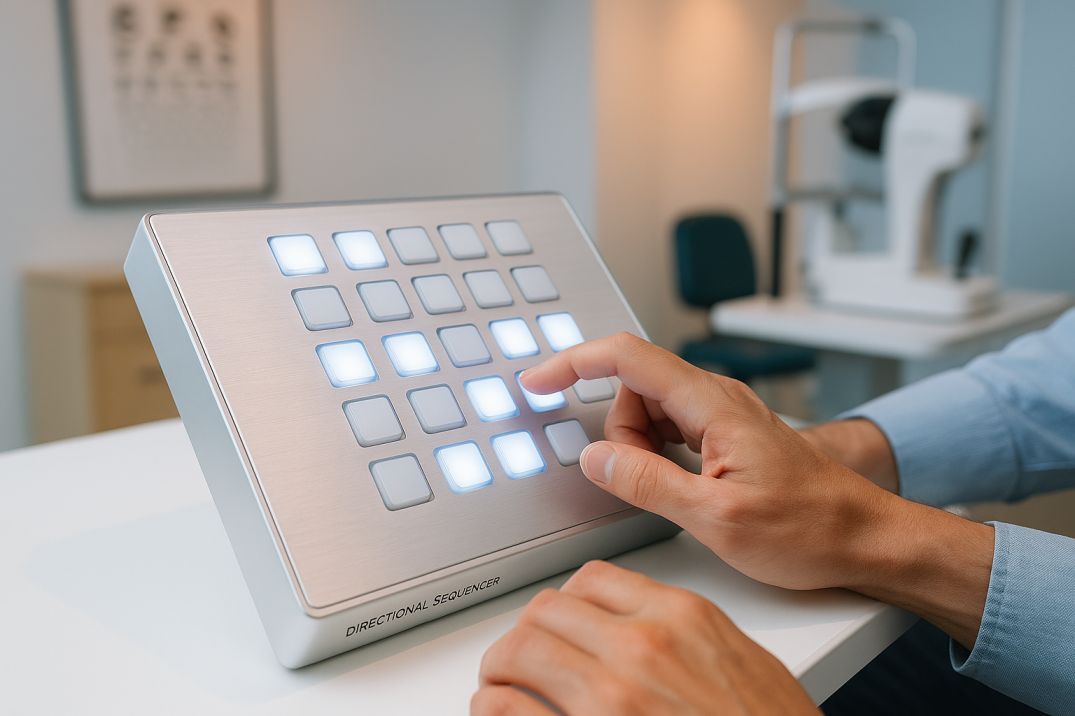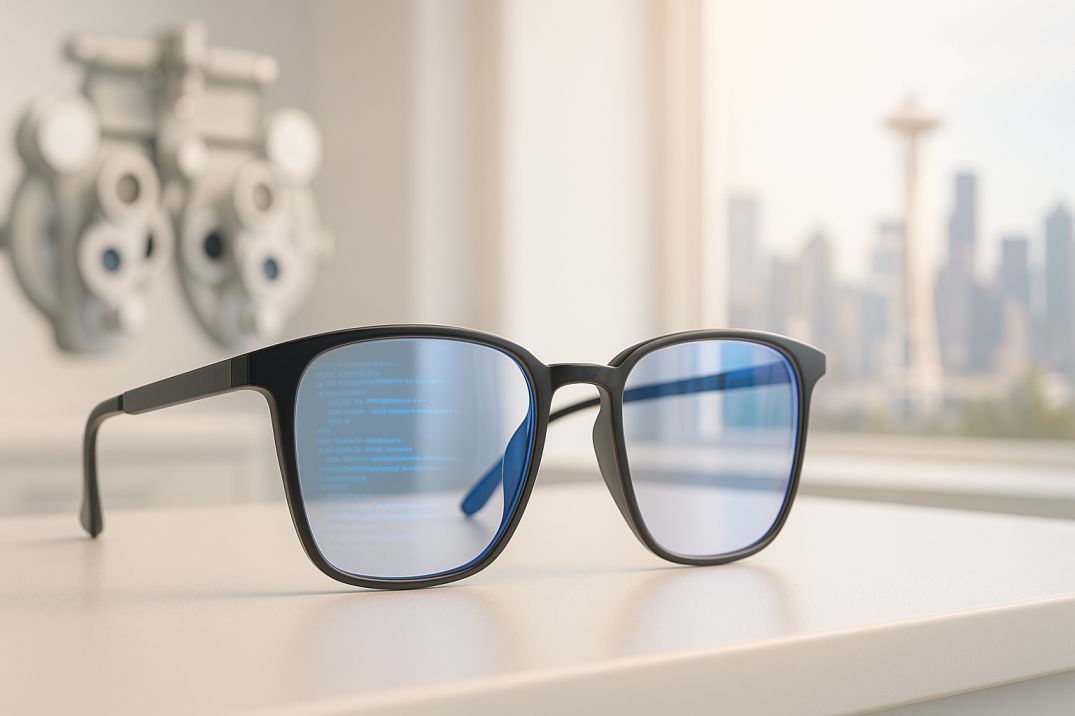Visual Training Devices: Science-Backed Solutions for Better Vision
Bottom Line Up Front: Visual training devices are revolutionizing how we approach eye health and performance enhancement. From cutting-edge VR systems to specialized eye exercise tools, these devices offer scientifically backed solutions for improving vision, treating eye conditions, and optimizing visual performance across all age groups.
What Are Visual Training Devices?
Visual training devices are specialized tools and technologies designed to improve visual skills, treat eye conditions, and enhance overall visual performance. These devices range from simple handheld tools to sophisticated virtual reality systems that help train your eyes and brain to work together more effectively.
Unlike traditional corrective eyewear that adjusts focus, visual training devices actively engage your visual system to strengthen eye muscles, improve coordination, and enhance processing speed. They’re increasingly used by eye care professionals, athletes, students, and anyone looking to optimize their visual abilities.
The Science Behind Visual Training
How Visual Training Works
Recent research published in Experimental Brain Research (May 2025) demonstrates that visual training programs can lead to “87% improvements in search time and 80% of patients making fewer errors” when properly implemented. The science is based on neuroplasticity – your brain’s ability to form new neural connections throughout life.
Visual training devices work by:
- Strengthening eye muscles through targeted exercises
- Improving binocular coordination between both eyes
- Enhancing visual processing speed in the brain
- Developing better tracking and focusing abilities
- Increasing peripheral awareness and visual field engagement
The Role of Technology in Modern Visual Training
Modern visual training platforms like Eye Hero use “dichoptic training” methods with interactive games that can be completed “from the comfort of your home”, making professional-grade therapy more accessible than ever before.
Types of Visual Training Devices
1. Virtual Reality (VR) Training Systems
VR represents the cutting edge of visual training technology. These systems create immersive environments where users can practice visual skills in controlled, repeatable scenarios.
Key Features:
- Immersive 3D environments for realistic training scenarios
- Customizable difficulty levels that adapt to your progress
- Real-time performance tracking and analytics
- Multi-sensory feedback combining visual, auditory, and haptic inputs
Popular VR Systems:
- NeuroTrainer: Developed in partnership with the National Science Foundation, combining “neuroscience and virtual reality” for peak performance training
- Optics Trainer VR: Specializes in eye movement training and peripheral vision enhancement
- EYEBAB Softboard: Features a giant interactive tablet with patented touch technology
2. Digital Training Platforms
These software-based solutions can be accessed through computers, tablets, or smartphones, making them highly accessible for home use.
Leading Platforms:
- Eye Hero: Offers “30-minute daily interactive games” with “personalized onboarding” and “real-time analytics”
- Vizual Edge: The “#1 online vision and cognitive training tool trusted by athletes, eye care patients, teams, and facilities for over 30 years”
- NeuroEyeCoach: Clinically validated in “the largest published eye movement training study” with proven effectiveness for both home and clinic settings
3. Traditional Training Tools
Despite technological advances, traditional tools remain valuable for specific training needs.
Common Tools Include:
- Brock String Devices: For convergence and divergence training
- Vision Therapy Cards: Red-green training cards for binocular fusion
- Prisms and Lenses: For accommodation and focusing exercises
- Eye Patches: For amblyopia treatment and andeye-teamingg exercises
4. Specialized Assessment and Training Equipment
Professional-grade devices used primarily in clinical settings offer the most comprehensive training options.
Examples:
- Bernell Corporation Equipment: Comprehensive “Vision Therapy” tools including “Accommodation,” “Anti-Suppression,” “Binocular Training,” and “Marsden & Saccadic Training” devices
- Good-Lite Vision Therapy Kits: Complete systems for professional eye care practices
Scientific Evidence and Research
Recent Breakthrough Studies
1. NovaVision NeuroEyeCoach Study (2025) Published in Experimental Brain Research, this study involving 296 patients demonstrated “significant improvements in visual search performance and a reduction in visual disability” for both home and clinic-based training.
2. NeuroTracker Validation Research. With “over 20 years of research,” NeuroTracker has identified “a minimum of 16 vital benefits,” including enhanced attention, improved working memory, and better visual information processing speed.
3. VR Training Effectiveness Review A systematic review of 330 studies found that virtual reality training effectiveness varies but shows promise when properly implemented with appropriate methodological controls.
Key Research Findings
Recent studies reveal several important insights about visual training device effectiveness:
- Improved Focus: VR-trained employees were “up to four times more focused during training than their e-learning peers and 1.5 times more focused than their classroom colleagues”
- Enhanced Confidence: Training participants showed “up to 275% more confident to act on what they learned after training”
- Faster Learning: What traditionally “took two hours to learn in the classroom could be learned in only 30 minutes using VR.
Benefits of Visual Training Devices
For Eye Health and Medical Conditions
Amblyopia (Lazy Eye) Treatment: Visual training devices offer modern alternatives to traditional eye patching. VR games with “blurred vision” therapy sessions were found to improve the visual acuity of participants in treating amblyopia.
Dry Eye and Computer Vision Syndrome Interactive training programs help strengthen eye muscles and improve blinking patterns, reducing strain from prolonged screen time.
Post-Stroke and Brain Injury Recovery Vision therapy can “effectively treat the visual consequences of brain trauma (including double vision, balance disorders, reading problems, dizziness, etc.)”.
For Athletic Performance
Sports Vision Enhancement Athletes report benefits including: “enhanced focus,” “improved reaction time,” “expanded peripheral vision,” and “boost your hand-eye coordination“.
Competitive Advantages: Professional sports teams increasingly use visual training to gain a competitive edge. The cognitive training market is “currently worth $1.98 billion (US) and set to rise to over $8 billion by 2021”.
For Academic and Professional Performance
Learning Enhancement Studies show visual training can improve “reading performance (accuracy, speed, and comprehension), visual attention, motor balance, and coordination in children” with learning disabilities.
Workplace Benefits: Improved visual skills translate to better productivity, reduced eye strain, and enhanced safety in visually demanding jobs.
How to Choose the Right Visual Training Device
Consider Your Specific Needs
For Medical Conditions:
- Consult with an eye care professional first
- Look for clinically validated devices
- Consider devices that offer progress tracking
- Ensure the device addresses your specific condition
For Performance Enhancement:
- Evaluate your primary visual demands (sports, reading, computer work)
- Consider devices that offer sport-specific or task-specific training
- Look for adaptive difficulty levels
- Check for compatibility with your existing technology
For General Eye Health:
- Start with user-friendly platforms that offer comprehensive programs
- Consider devices that provide educational content about eye health
- Look for programs that address multiple visual skills
- Ensure the device fits your schedule and lifestyle
Key Features to Look For
1. Scientific Validation Choose devices backed by peer-reviewed research and clinical studies.
2. Personalization Look for systems that adapt to your progress and specific needs.
3. Professional Support: Consider whether the device offers access to eye care professionals or training guidance.
4. Progress Tracking: Ensure the device provides meaningful metrics to monitor your improvement.
5. User Experience The device should be engaging and easy to use consistently.
Getting Started with Visual Training
Step 1: Professional Assessment
Before beginning any visual training program, consult with an eye care professional to:
- Assess your current visual abilities
- Identify specific areas for improvement
- Rule out underlying eye health issues
- Get personalized recommendations
Step 2: Choose Your Platform
Based on your assessment and goals, select a device or platform that:
- Addresses your specific needs
- Fits your budget and lifestyle
- Offers appropriate support and guidance
- Has a track record of effectiveness
Step 3: Establish a Routine
Most visual training programs require consistent practice:
- Frequency: Most effective programs recommend “30-minute daily” sessions
- Duration: Plan for several weeks to months of training
- Environment: Ensure you have a suitable space for training
- Compliance: Track your progress and maintain motivation
Step 4: Monitor Progress
Regular assessment helps ensure you’re benefiting from training:
- Use built-in progress tracking features
- Schedule follow-up appointments with your eye care provider
- Adjust training parameters based on improvement
- Celebrate milestones and achievements
The Future of Visual Training Technology
Emerging Technologies
Artificial Intelligence Integration Visual AI is becoming “the backstage magician ensuring that companies stay ahead in the competition” by automating analysis and providing personalized training recommendations.
Advanced VR and AR Systems The AR and VR training market is “expected to reach a valuation of USD 405.4 billion by 2034, expanding at a healthy CAGR of 38.3%” from USD 15.84 billion in 2024, indicating massive growth and innovation ahead.
Brain-Computer Interfaces Brain training devices are evolving with “neurofeedback” that provides “clear, immediate” feedback to help users “recognize and reshape mental patterns in real time”.
Market Trends and Adoption
The visual training device market is experiencing rapid growth driven by:
- Increased screen time and digital eye strain
- Growing awareness of the importance of visual skills
- Advances in VR and AI technology
- Expanding applications in sports and education
- Greater accessibility of home-based training solutions
The broader cognitive assessment and training market demonstrates this growth, valued at “USD 5.5 billion in 2024” and expected to reach “USD 35.1 billion in 2033, at a CAGR of 30.2%”.
Safety Considerations and Best Practices
General Safety Guidelines
Use Proper Lighting: Ensure adequate lighting when using any visual training device to prevent eye strain.
Take Regular Breaks. Follow the 20-20-20 rule: every 20 minutes, look at something 20 feet away for 20 seconds.
Monitor for Side Effects: Discontinue use and consult a professional if you experience:
- Persistent headaches
- Dizziness or nausea
- Worsening vision symptoms
- Unusual eye discomfort
Age-Appropriate Use: Ensure devices are suitable for the user’s age and developmental stage.
Professional Supervision
While many visual training devices are designed for home use, professional supervision is recommended for:
- Medical conditions requiring treatment
- Children with developmental visual issues
- Complex visual problems
- Monitoring treatment progress
Cost Considerations and Insurance
Device Costs
Visual training devices range from affordable mobile apps to professional-grade equipment:
- Mobile Apps: $10-50 per month
- Computer-Based Programs: $100-500 one-time or subscription
- VR Systems: $400-2000+ depending on sophistication
- Professional Equipment: $1000-10,000+ for clinical-grade devices
Insurance Coverage
Coverage varies significantly:
- Medical Necessity: Some insurance plans cover devices prescribed for medical conditions
- Vision Therapy: Coverage depends on your specific plan and diagnosis
- Preventive Care: Most plans don’t cover devices for performance enhancement
- HSA/FSA: Many devices qualify for health savings account reimbursement
Conclusion
Visual training devices represent a significant advancement in eye care and performance enhancement. With clinical studies showing “87% improvements in search time and 80% of patients making fewer errors”, these technologies offer real benefits for people of all ages and visual needs.
Whether you’re seeking to treat a specific eye condition, enhance athletic performance, or maintain optimal eye health in our digital age, visual training devices provide accessible, effective solutions. The key is choosing the right device for your specific needs and using it consistently under appropriate guidance.
As technology continues to advance and the market grows toward “USD 405.4 billion by 2034”, we can expect even more innovative and effective visual training solutions to emerge. By staying informed and working with qualified eye care professionals, you can take advantage of these powerful tools to optimize your visual performance and maintain healthy vision throughout your life.
Ready to improve your vision?
Consult with a qualified eye care professional to determine which visual training approach is right for you. Your eyes are your windows to the world – invest in keeping them healthy and performing at their best.
FAQs
-
Visual training devices are tools or apps designed to improve eye coordination, focus, and visual processing through targeted exercises and games




